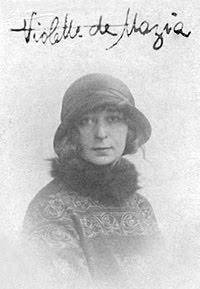Violette de Mazia, ¿de Dewey?
Born in Paris in 1899, Violette de Mazia studied art in the studio of Robert Christie at Hampstead Conservatory, the Camden School of Art, and London Polytechnic School in England. When she moved to the United States in the 1920s, she continued her studies by enrolling in philosophy and art appreciation classes taught by Dr. Thomas Munro at the Barnes Foundation in Merion, Pennsylvania.
Soon after those initial classes, Dr. Albert C. Barnes offered de Mazia a teaching position. At the Foundation, de Mazia taught, wrote, met with artists, and traveled to Europe for study, museum visits, and to assist with art purchases. She worked closely with Barnes and his colleagues, including Columbia University Professor John Dewey, philosopher George Santayana, art dealer Paul Guillaume, and the painters William Glackens and Alfred Henry Maurer.Over the years, de Mazia became the driving force behind the art education program, developing an original program of study
that, based on awards and honors she received, was considered a significant approach to the understanding of art. Ms. de Mazia was named Director of Education at the Barnes Foundation in 1950.
Following the death of Barnes in 1951, de Mazia was appointed trustee and Director of Education for life and taught the methodology to students of the Foundation. Under Ms. de Mazia, students learned about the aesthetic principles of paintings, but also that those same principles equally apply to music, literature, drama, architecture, fashion, gastronomy, athletics, and any other aspect of human activity.
In addition to teaching, de Mazia co-authored four books and wrote a number of essays. Among the many public accolades, de Mazia received honorary degrees from St. Joseph’s University, La Salle University, Moore College of Art and Design, and Lincoln University.
